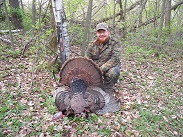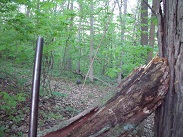Spring Gobbler Strategies
Early Morning Early Morning Calling Midmorning Afternoon
Roosting Birds Decoy Setup
Turkey Hunting Weather Conditions
Calm Days Windy Days Rainy Days Snowy Days Hot Days
Early Morning Setups 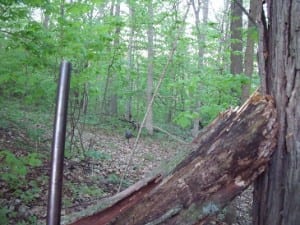
Listen for gobbler thunder from a ridge top, knoll or similar high spot at dawn. The higher you hunt the easier it is to hear and course faraway gobbles. If a bird roars on a nearby oak flat or just off the point of a ridge, great! Sneak quietly down into calling position.
The first time a turkey gobbles, don’t tear down the woods running to him. Keep cool; slip 25 to 50 yards in the direction of the gobble; and check up. A tom will usually gobble 2 or 3 more times, and hopefully more than that. Listen to those calls and draw a solid line to the bird’s roost tree.
Using ridges, hollows and foliage for cover, you should have no trouble sneaking within 200 yards of a roosted turkey. Whenever possible, try to cut the distance to 125 or even 100 yards. The less terra firma between you and a bird, the better the odds that he’ll pitch down and drift to your calls at daybreak.
For some strange reason, most toms are reluctant to pitch from their limbs and strut downhill to calling. Try to position above a roosted bird, or at least on the same gradient plane with him.
As you approach a gobbling turkey, scan the woods for a fence, creek, gully or strip of thick brush, and maneuver to take any hazard large or small out of play. Strive to set up where the terrain is gently rolling and fairly open, which makes it easy for a tom to strut toward your calls.
The best strategy of all is to anticipate where a gobbler will go to gather hens, then set up to block his way. Is there a field, food plot, clear-cut, burn or open creek bottom within a half-mile or so of a tom’s roost tree? If so, beat feet over in that direction and settle in. When the turkey flies down and heads for his strut zone, you’ll be in good position to cut him off and coax him with calling.
Early Morning Calling 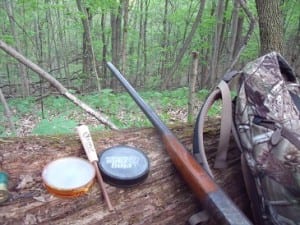
Let’s say you do it right and slip within 100 yards of a roosted turkey that is gobbling hot and heavy. The more the bird roars, the more you feel an uncontrollable urge to cluck and yelp. But be careful! Too much calling at first light can hang a tom on his limb as he waits for the hot “hen” to sail or walk beneath his roost tree. And the longer he sits up there and fails to see a girl, the more he smells a rat. When the bird finally flies down 30 minutes later, there’s a good chance he’ll run the other way.
So fight the urge to call too early. Wait until pink illuminates the sky. Then give a bird some pillow talk to let him now you’re there. A couple of sultry tree clucks and yelps are about right.
If the turkey bellows shut the heck up! He has honored you as a hen, he likes what he heard, and he knows where you are. Let him fly down and come looking for you. But if the tom fails to gobble, cluck and yelp a little louder to focus his attention in your direction.
If he still doesn’t talk, it’s no big deal. Listen for the bird to fly down, then hit him with a spirited hen cackle. Try flapping a Primos turkey wing against your leg to sound like a hen pitching to the ground. If the tom gobbles and steps your way, you might not need to call again. But if he hangs up after 5 minutes or so, cluck, yelp and purr a little louder. As long as the turkey hangs around and gobbles keep playing the game. Most hunters move too quickly on toms that might eventually strut to their calls 30 minutes or so after fly-down time.
Midmorning Tactics Back Up
Turkeys might gobble like crazy on the roost. But for an hour or two after daybreak the woods may fall as quiet as a mausoleum. That’s because the hens and toms are courting and breeding. Toms strut and drum but gobble little if at all as they have their fun. The so-called “gobbling lull” is the toughest time of day to hunt.
But along about 9 o’clock some hens begin to leave some of the gobblers. Some girls simply lose interest in the boys, while others slip off to lay eggs. Lovesick toms are driven to be around hens all the time in the spring, so they immediately begin searching for more company. Some rowdy 2-year-old males may start gobbling hard in hopes of attracting new hens. Older long beards strut and drum intensely, and they are stoked to shock gobble. 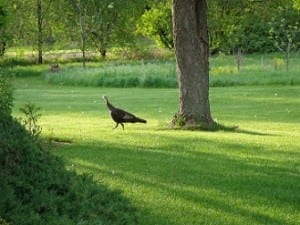
“Gobblers strut around all morning, and suddenly they look up and their hens are gone,” says my friend Harold Knight of Knight and Hale Game Calls. “They almost fly into a panic. If you slip around the woods and call, those lonesome turkeys will hear you and gobble. If they gobble a couple of times at your calls, they’re generally pretty easy to call in.”
There’s another big reason the midmorning hours are hot. You’ve got plenty of elbow room to do your thing. “Most hunters have gone home or to work,” notes Knight. “A lot of the gobblers that were called to and maybe spooked first thing in the morning have settled back down. The woods have calmed down and the turkeys are back on their normal routine. If you’ve got the day off, hang in there. You’ll have the woods to yourself as you call to those lonely gobblers.”
Beginning around 9:00 a.m. walk old logging roads, field edges, foot trails on ridges…you get the idea. Pause often and listen for gobbles. Try to strike toms with calls. ”
I like to blow a hawk or crow call,” says Knight. “Lonely turkeys have so much pent-up energy that they’ll often shock gobble at those sounds. The minute a turkey gobbles, I move in, set up in a good spot and switch over to soft hen calls.”
If locator calls fail to produce, turn to turkey calling. “My favorite calls are loud yelps and especially cutts,” says Knight. “If a gobbler’s hens have left and he’s strutting around by himself, he’ll nail a sharp cutt most of the time.”
Knight offers one exception to the rule of calling aggressively to strike toms. “When I hunt a public area late in the season, I figure most of the gobblers are call shy,” he says. “So I tone down my calling. I still cover lots of ground and call down into hollows and around fields, but I yelp and cutt softer and not as much.”
Afternoon Strategies 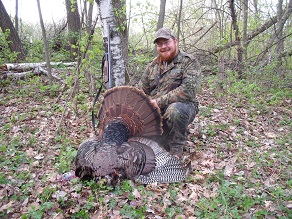
Combined, more than 25 Southeastern, Midwestern and Western states permit all-day turkey hunting in the spring. If you live in or travel to one of these states you can experience some great action beginning after lunch and continuing until roosting time. Most of the early-morning hunters are out of the woods. But the gobblers are still there, most of ’em deserted by hens and stoked to gobble at your locator calls or hen cutts.
But keep this in mind. You can’t expect a turkey to gobble 50 or more times in the afternoon like he might first thing in the morning. Most birds won’t even gobble as much as they might around 9 or 10 a.m. You need to crow call or hen cutt and listen closely for a faint gobble or two. Then move in and listen for softer sounds, like a turkey strutting or walking in the leaves. A lot of turkeys, especially old Easterns, will gobble only once or twice in the afternoon, but they’ll come to your calls fast and silently.
Afternoon hunting generally peaks from around 2 to 4:30 p.m., but you might as well hunt right up until dark some days. Gobblers love to roost within 50 to 200 yards of hens. If a turkey hears you yelping and cutting late in the day, he might come in to roost in the area. Better yet, he might run over to check out the hen before he flies up.
Roosting Toms Back Up
One of the oldest tricks in the book in to “put a gobbler to bed.” On spring evenings hit the woods and listen for a turkey to gobble when he flies up to roost at dusk. If a bird doesn’t roar on his own, owl hoot, crow call or hen cutt. Hopefully one or more birds will gobble and give away their roost trees. Even if no toms talk you should listen for heavy wings thumping up into the treetops.
If you hear a turkey gobble or fly up, you know where to hunt the next morning. Slip into the area well before first light, set up 100 to 150 yards away from a turkey’s roost and wait for tom to roar. Then give him your best calling.
“A roosted turkey sure ain’t a roasted turkey!” goes an old Southern saying. That’s right. You might come back the next morning and a turkey you roosted won’t gobble. Or he might gobble his fool head off, fly down and run straight away from your calling. You just never know. Still, you should try to roost a few birds each spring. It sure never hurts to plan a morning hunt in an area where you put a gobbler to bed the night before.
Decoy Setups
We’ve developed a love-hate relationship with decoys over the years. Granted, some lovesick toms run to fakes. But we’ve watched far too many birds stop 50 yards out, explode into strut and wait for the “hen” to walk the rest of the way to them. Here’s a good way to cut down on some of those hang-ups.
Stake a fake hen 20 yards past a calling setup. This puts you smack between the decoy and the gobbling turkey you’re yelping to. If the bird works in and stops 50 yards from the imposter, great! He’s 30 yards or so off the end of your shotgun barrel.
A few final notes: Pack two foam hens and a foam jake (from Feather Flex or Carry Lite) in your vest. Set the trio on their stakes; they’ll spin enticingly in the breeze to catch the eye of a gobbler. Setting a jake (or strutting Tom) with a hen or two is important, as a mature gobbler will sometimes see him and come in to kick his butt (the old guy thinks the jake is courting a hen). Decoys work best in fields, logging roads and other open areas where gobblers can spot them a long way off.
If the turkeys wont come to your calling, try letting the decoys do the talking for you. Just setup two or more decoys in an open area and wait.
Turkey Hunting Conditions Back Up
Calm Days 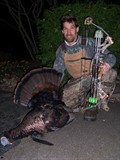
As a rule turkeys gobble best on clear, calm, high-pressure mornings in the spring. Stand on a ridge or bluff at dawn and you’re apt to hear birds gobbling a mile or more away in all directions.
Not only can you hear well on a nice day, your calls also ring true and carry far. Any mouth or friction call works well. Since yelps and cutts carry nicely, you don’t have to hammer away on calls. Soft to moderately loud calling is most realistic.
In the fall flocks are vocal on calm days. Pause on a hardwood ridge and you might hear birds clucking, yelping and purring 200 to 400 yards away. Listen for birds flying down from a roost, or scratching in the leaves for feed.
About the only down side to a calm day is that turkeys might hear you coming and spook, especially when the fallen leaves are dry and deep in October or November. In this case try to walk along field edges, logging roads and the like. Pause often to call and listen for turkeys calling back or scratching.
Windy Days Back Up
Wind is the bane of turkey hunters. For one thing birds don’t gobble very much after they’re been whipped around in trees all night. Same thing in the fall; birds don’t feel like roost clucking or yelping much after windy nights. Even if birds gobble or yelp a few times you probably can’t hear those calls because of a stout breeze.
Here are a few ways to fight the wind. ·
Hunt early in the morning. The wind often dies at dawn and stays down for an hour or so before it starts to whistle again.
Check for single birds or flocks roosted on the lee sides of ridges, hills or points.
In midmorning and afternoon, check for strutters or flocks loafing in hollows, draws, creek bottoms and other low, wind-broken habitats.
Use friction calls. High-pitched box and pot-peg calls seem to pierce to wind better than diaphragms.
If a turkey gobbles back at your calls, set up quickly and be ready. Since the wind limits your hearing a tom is likely closer than he sounds.
Rainy Days Back Up 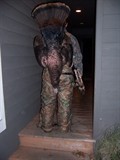
Turkey hunting is poor in heavy rain. The birds are neither vocal nor active, so there’s really no reason to get out there and get drenched. But say one morning a low front passes through. The sky brightens and the sun pops out after a night of downpours or storms. Hit the woods! In the spring many toms start gobbling for hens. And in the fall flocks begin to move around and feed.
If it’s misty, foggy or raining lightly put on a rain jacket and go hunting. Some toms gobble great on gray days.
On rainy mornings in the spring turkeys tend to stay in their roost trees longer than normal. I’ve called to gobblers that didn’t fly down until 7:30 or even 8:00 a.m. Same thing in the fall, flocks linger in trees well after first light. Keep this in mind as you walk around and call.
Fields, food plots, power line rights-of-way and similar open areas are great places to check for single turkeys or flocks on rainy days. Many turkeys don’t like to hang around in dripping woods, largely because their hearing is impaired. They move out into openings where they can hear better. Also the birds try to avoid water-soaked brush and saplings.
Forget about using wooden box calls or natural slates with wooden pegs-they won’t ring true on rainy or misty days. Use a diaphragm or an aluminum or glass pot with a carbon striker. Of course diaphragm or tube calls work okay.
Snowy Days Back Up
Snow is not uncommon if a state’s fall turkey season runs into December. And every once in a while you might run into some white stuff on a spring hunt in the Midwest, North or West. A couple of years ago I hunted in New Mexico in May. One night it snowed a foot, and the next morning the toms gobbled like crazy!
Expect turkeys to roost in warm, sheltering evergreen trees on cold, snowy nights. Pockets of pines or cedars on the lee sides of hills or ridges are great places to check for birds. The next morning the turkeys will stay in the trees longer than normal. When they fly down, toms often linger beneath the conifers to strut or feed where the ground is bare.
Try tracking turkeys in snow. Look for fresh tracks and upturned leaves where birds raked for food. Keep a sharp eye ahead. Turkeys are easy to see against a canvas of snow. But then so are you! To keep roosted or feeding birds from spotting you, move slowly and use ridges, draws and other terrain breaks for cover.
If it’s still snowing lightly when you hunt, use a diaphragm, tube, aluminum or glass call. Keep wooden calls and strikers in your vest because they’ll be affected the moisture.
Hot Days
In the spring the sun is intense and the days heat up rapidly, especially in the South. Whenever I hunt in Texas, Mississippi, Florida, etc., I key on shady cover beginning around 10 a.m. or so. When the temperature soars into the 70s or 80s and the sun shimmers on the black backs of toms, they often move into cool, shadowy creek bottoms, oak hammocks, live oak mottes and the like. Sneak close to these strutting/loafing areas and crow call or cutt-you’re likely to make a turkey shock gobble.









